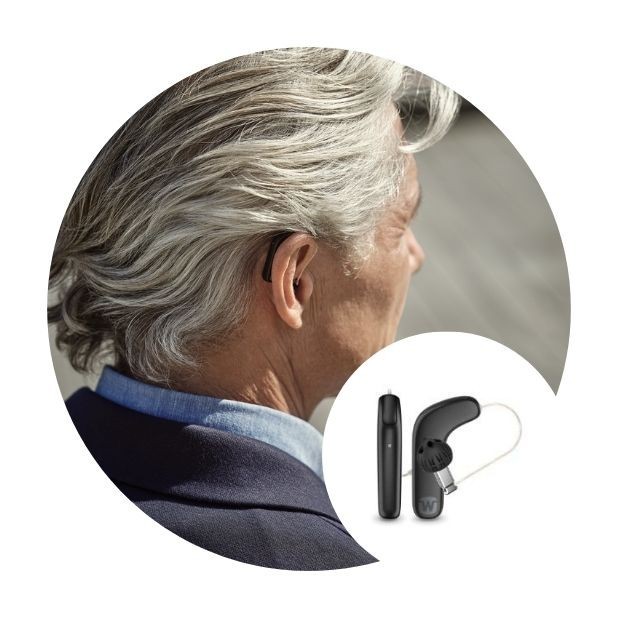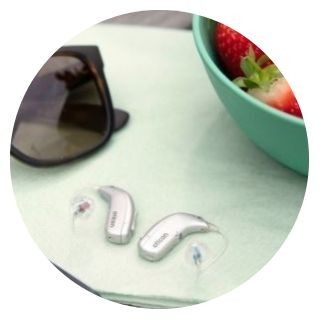Receiver in Canal RIC Hearing Aids
Exploring the different hearing aid styles available
| Hearing Aid UK 18/12/2025 Update |
The differences between RIC hearing aids
The crucial difference is that in Receiver in Canal hearing aids (RIC), the casing behind the ear holds the microphone, amplifier, and processor, but the receiver/speaker is situated in a small dome that sits directly in the ear, the two parts being connected by a thin wire.
RIC hearing aids offer a combination of discretion, advanced technology, and enhanced listening experience, making them a preferred choice for those with various types of hearing loss.
The main top three benefits of RIC hearing aids are that they are small, durable, and comfortable. Discover the other RIC hearing aid benefits and disadvantages below.

What is a Receiver in Canal hearing aid?
Receiver in Canal hearing aids (RIC) can be seen as the new generation of high-powered and technologically advanced digital hearing aids.
Are RIC hearing aids any good? They are now one of the most popular types of hearing aids, as they combine many of the advantages of Behind the Ear (BTE) hearing aids.
Such as sitting partially behind the ear, and thus being able to include lots of clever technology.
This design means that Receiver in Canal (RIC) are often smaller than BTE designs and they are able to produce a more natural sound and suffer less from feedback.

The Pros and Cons of RIC Hearing Aids (RIC)
What are the benefits of RIC hearing aids?
RIC hearing aids are great if you struggle to hear high-pitched sounds
For many people, the first symptom of their hearing loss is an inability to hear high-pitched sounds. Due to their two-part design, Receiver In Canal (RIC) hearing aids are particularly good at amplifying high-pitched sounds yet still producing a natural sound result.
Receiver In Canal (RIC) hearing aids are particularly good for people with early-onset or mild to moderate hearing loss. However, please note that there are also many Receiver In Canal (RIC) hearing aids that have been specifically designed for those with more severe levels of hearing loss.
You’ll hardly notice that you are wearing a RIC hearing aid
Again, due to their two-part design, Receiver In Canal (RIC) hearing aids are extremely small and lightweight, making them very comfortable to wear. In fact, many users report that the only reason they know that they are wearing their Receiver In Canal (RIC) hearing aid is that their hearing is so much better!
RIC hearing aids allow you to hear a more natural sound
Receiver in Canal (RIC) hearing aids are often reported as producing some of the most natural sound quality of all the different types of hearing aids. This is due to two factors.
Firstly, as the speaker/receiver sits directly in the ear, it allows for sounds to be transmitted directly into your ear canal, meaning that they are less susceptible to distortion.
Also, as Receiver In Canal (RIC) features a more open dome in the ear, which avoids blocking the ear and thus mitigates any issues of occlusion.
RIC hearing aids are inconspicuous
Considering that Receiver In Canal (RIC) hearing aids do sit outside of your ear, they are actually much more discreet than you might think. The casing that sits behind your ear is usually incredibly small and slim, and the wire that connects that to the ear dome is often almost invisible unless someone is specifically looking for it.
Receiver In Canal (RIC) hearing aids are also available in a range of colours that can blend in with your hair or skin tone.
RIC hearing aids don't occlude the ear canal
Occlusion of the ear canal results from the entire entrance to the canal being covered or blocked by a hearing aid (or other foreign objects).
This can cause issues such as hearing your own voice too loudly, your voice sounding hollow, experiencing noisy and annoying sounds when chewing or swallowing food, and an unpleasant feeling that your ear is blocked.
As the receiver/speaker in Receiver In Canal (RIC) hearing aids leaves the entrance to your ear canal partially open, then issues of occlusion are thankfully avoided.
Annoying feedback is reduced with RIC hearing aids
Many users of Receiver In Canal (RIC) hearing aids report that they experience significantly lower levels of feedback with these compared to other types of hearing aids. Due to the separation of the microphone/amplifier and the speaker/receiver in Receiver In Canal (RIC) hearing aids.
It means that there is much less chance of signal confusion within the device itself, thus the annoying whistling sounds produced by the feedback are reduced.

RIC Hearing Aids
What are the disadvantages of Receiver in Canal hearing aids?
The receiver can be susceptible to damage
As the receiver/speaker part of a Receiver In Canal (RIC) hearing aid is positioned directly in the ear canal itself, you may find that it is more susceptible to damage from sweat and natural ear moisture, etc, than many other types of hearing aids.
You are more liable to lose RIC hearing aids
This is a common misconception, as 8/10 RICs sold are rechargeable; they are therefore the only hearing aids that you have to put in the box when you take them out, making it a lot less likely that you will misplace them. Let's compare a few of the other hearing aid models with RIC hearing aids below:
RIC vs BTE hearing aids
What is the difference between RIC and BTE hearing aids? Receiver-in-the-Canal (RIC) hearing aids, also known as Receiver-in-the-Ear (RITE) or canal receiver technology (CRT), offer a compact alternative to standard BTE models while retaining versatile features.
These RIC aids, like traditional BTEs, rest comfortably behind the ear. However, they differ in that their speaker is situated outside the housing, connected to a slim ear wire positioned near the eardrum.
Because sound travels a short distance with minimal loss, less sound energy and battery power are needed, resulting in an improved listening experience. This design combines the benefits of discretion, comfort, and enhanced sound quality for wearers.
RIC vs CIC hearing aids
What is the difference between CIC and RIC hearing aids? Receiver-in-Canal (RIC) hearing aids have a small behind-the-ear component with a wire leading to the ear canal, making them versatile for various hearing loss levels. They offer advanced features and are less prone to feedback, but are more visible.
Completely-in-the-Canal (CIC) hearing aids are custom-made to fit deep inside the ear canal, making them virtually invisible.
However, they suit mild to moderate hearing loss, have limited features, and may cause feedback and a sense of earplugging. RIC strikes a balance between performance and visibility, while CIC excels in discretion.
The choice depends on hearing needs, cosmetic preferences, and lifestyle. Consultation with an audiologist is crucial for the best decision.
Summary
RIC hearing aids feature a small Behind-the-Ear unit connected by a thin wire to a receiver placed in the ear canal. This design offers natural sound quality, comfort, and discreet wear, making it a popular choice in the UK.
| Main benefits | Considerations | RIC vs other styles |
| Lightweight and comfortable | Receiver can be prone to moisture damage | BTE: RICs are smaller and more efficient |
| Reduced feedback and occlusion | Smaller design may be easier to misplace | CIC: RICs offer more features, CICs are more discreet |
| Rechargeable options help prevent loss | Needs to be cleaned regularly | RIC hearing aids strike a balance between performance, discretion, and technology |
Need more support with RIC hearing aids?
RIC hearing aids provide a discreet and advanced solution for individuals with hearing loss. Their inconspicuous design, advanced technology, comfortable fit, and customisation options make them a popular choice among wearers.
With improved sound quality, wireless connectivity, and a natural listening experience, RIC hearing aids empower individuals to overcome the challenges of hearing loss.
►Explore rechargeable RIC hearing aids here
►Explore RIC hearing aids with Bluetooth here
Discover More Hearing Aid Styles Below
Our specialist service includes:
Do not spend hundreds of pounds without getting a second opinion from us.
Please call us on 0800 567 7621
 Not only are the prices great, but the service is fantastic! Many thanks to your team.
Not only are the prices great, but the service is fantastic! Many thanks to your team.Watch Signia's RIC hearing aid video below
What's included in our hearing aid prices?
Other pages you might find useful
Common FAQs about RIC hearing aids in the UK
Yes, modern Receiver-in-Canal (RIC) hearing aids offer a discreet and powerful solution for hearing loss. These small RIC hearing aids are designed to be inconspicuous while delivering excellent sound quality.
Their behind-the-ear component is minimal, with a thin wire leading to the receiver placed in the ear canal. Despite their size, small RIC hearing aids often incorporate advanced features like noise reduction, Bluetooth connectivity, and directional microphones.
They are suitable for various degrees of hearing loss and provide wearers with a comfortable and versatile hearing experience. These devices blend functionality with subtlety, allowing individuals to enjoy improved hearing without drawing unnecessary attention.
How much do RIC hearing aids cost?
The price of RIC hearing aids is influenced by individual preferences and financial considerations, making it a variable factor unique to each person.
Hence, it is crucial to consult with one of our hearing care professionals to identify the ideal hearing aid tailored to your needs.
It's worth noting that our hearing aid costs encompass more than just the device's price; they also encompass valuable benefits like lifetime aftercare at no additional charge.
One of the main reasons why our customers buy RIC hearing aids with us is because we offer home visits and prices that are upto 40% off the high street.
Click here to compare and discover hearing aid prices in the UK.
How do you clean RIC hearing aids?
Cleaning RIC hearing aids are essential for maintaining their performance and longevity. To clean RIC hearing aids:
1. Daily Wipe-Down: Gently wipe the hearing aid and earpiece with a clean, dry cloth or a specialized cleaning brush to remove dirt, moisture, and earwax.
2. Earmold Cleaning: For RIC models with earmolds, remove and clean them separately using a mild soap solution and a soft brush or cloth. Ensure they are completely dry before reattachment.
3. Replace Wax Filters: Check and replace wax filters regularly, as they can clog with earwax. Follow the manufacturer's recommendations for replacement intervals.
4. Keep Dry: Store your RIC hearing aids in a dehumidifier overnight to remove moisture, which can damage the device.
Proper cleaning and maintenance ensure your RIC hearing aids continue to provide clear and reliable sound amplification.
How do you insert RIC hearing aids?
Inserting Receiver-in-Canal (RIC) hearing aids correctly is crucial for comfort and optimal performance. Follow these steps:
1. Clean Hands: Begin with clean hands to prevent transferring dirt or oils to the hearing aids.
2. Hold the Aid: Grasp the hearing aid by its body, avoiding contact with the microphone or receiver.
3. Turn On: If your hearing aid has a manual power switch, activate it now.
4. Position Behind Ear: Place the hearing aid comfortably behind your ear with the thin wire extending towards your ear canal.
5. Insert Earmold or Earpiece: If your RIC has an earmold or earpiece, gently insert it into your ear canal.
6. Secure and Adjust: Ensure the hearing aid feels secure and comfortable. Make any necessary adjustments to the wire or tubing for an optimal fit.
7. Check for Feedback: Listen for any whistling or feedback; if present, reposition the aid slightly.
With practice, inserting RIC hearing aids becomes second nature, ensuring improved hearing without discomfort.
Ask the Experts
6 Morton Lane
Walkwood
Redditch
Worcestershire
B97 5QA
Latest Launch
When we refer to a product as 'Latest Launch', we mean it is the latest to be released on the market.
New
When we refer to a product as 'New', we mean that the product is the newest hearing aid model on the market.
When we refer to a product as 'Superseded', we mean that there is a newer range available which replaces and improves on this product.
Older Model
When we refer to a product as an 'Older Model', we mean that it is has been superseded by at least two more recent hearing aid ranges.

